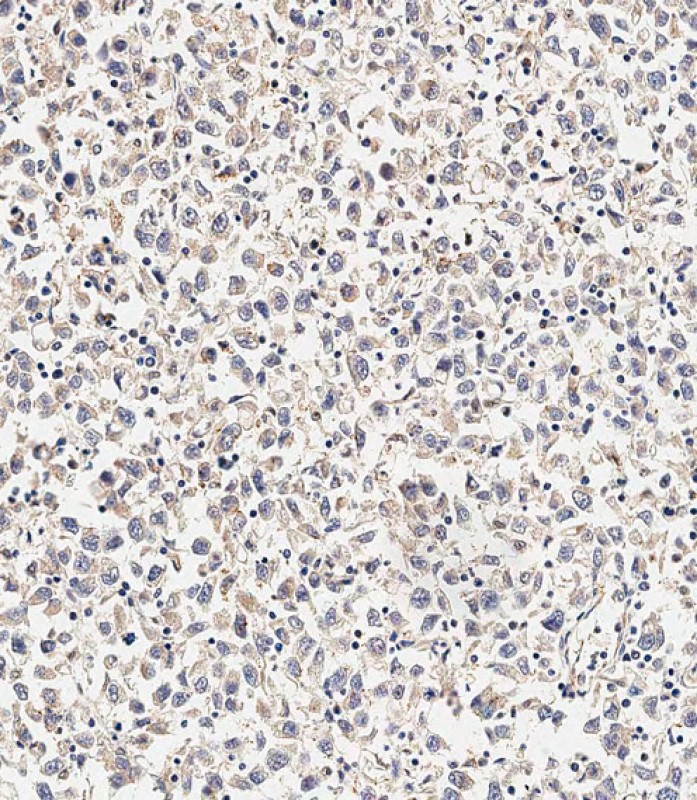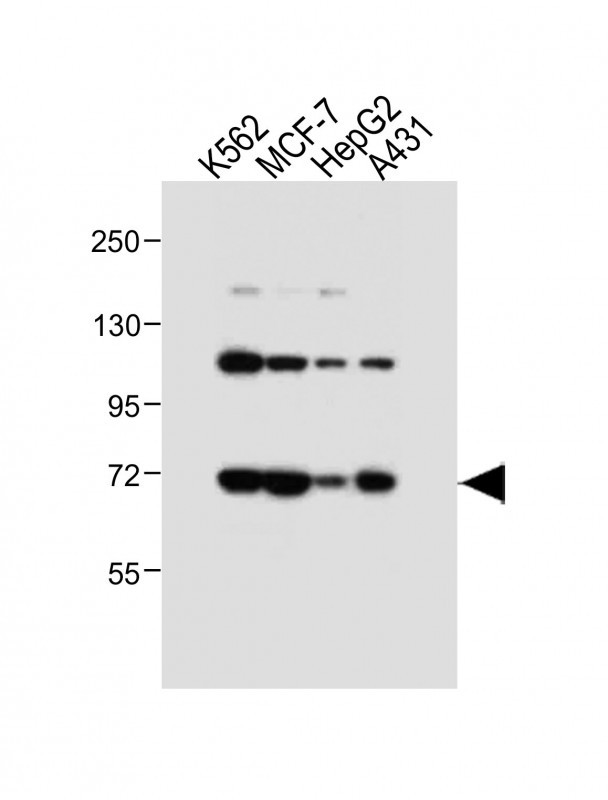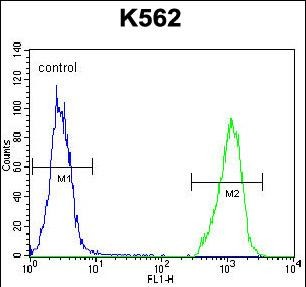SMPD1 Antibody (C-term)
Affinity Purified Rabbit Polyclonal Antibody (Pab)
- 产品详情
- 文献引用 : 1
- 实验流程
- 背景知识
Application
| IHC-P-Leica, WB, FC, E |
|---|---|
| Primary Accession | P17405 |
| Other Accession | Q0VD19, NP_000534.3 |
| Reactivity | Human, Mouse |
| Predicted | Bovine |
| Host | Rabbit |
| Clonality | Polyclonal |
| Isotype | Rabbit IgG |
| Calculated MW | 69936 Da |
| Antigen Region | 391-419 aa |
| Gene ID | 6609 |
|---|---|
| Other Names | Sphingomyelin phosphodiesterase, Acid sphingomyelinase, aSMase, SMPD1, ASM |
| Target/Specificity | This SMPD1 antibody is generated from rabbits immunized with a KLH conjugated synthetic peptide between 391-419 amino acids from the C-terminal region of human SMPD1. |
| Dilution | IHC-P-Leica~~1:500 WB~~1:4000 FC~~1:10~50 E~~Use at an assay dependent concentration. |
| Format | Purified polyclonal antibody supplied in PBS with 0.09% (W/V) sodium azide. This antibody is purified through a protein A column, followed by peptide affinity purification. |
| Storage | Maintain refrigerated at 2-8°C for up to 2 weeks. For long term storage store at -20°C in small aliquots to prevent freeze-thaw cycles. |
| Precautions | SMPD1 Antibody (C-term) is for research use only and not for use in diagnostic or therapeutic procedures. |
| Name | SMPD1 (HGNC:11120) |
|---|---|
| Function | Converts sphingomyelin to ceramide (PubMed:12563314, PubMed:1840600, PubMed:18815062, PubMed:25339683, PubMed:25920558, PubMed:27659707, PubMed:33163980). Exists as two enzymatic forms that arise from alternative trafficking of a single protein precursor, one that is targeted to the endolysosomal compartment, whereas the other is released extracellularly (PubMed:20807762, PubMed:21098024, PubMed:9660788). However, in response to various forms of stress, lysosomal exocytosis may represent a major source of the secretory form (PubMed:12563314, PubMed:20530211, PubMed:20807762, PubMed:22573858, PubMed:9393854). |
| Cellular Location | Lysosome. Lipid droplet. Secreted. Note=The secreted form is induced in a time- and dose-dependent by IL1B and TNF as well as stress and viral infection. This increase of the secreted form seems to be due to exocytosis of the lysosomal form and is Ca(2+)-dependent (PubMed:20530211, PubMed:20807762, PubMed:22573858). Secretion is dependent of phosphorylation at Ser-510 (PubMed:17303575). Secretion is induced by inflammatory mediators such as IL1B, IFNG or TNF as well as infection with bacteria and viruses (PubMed:12563314, PubMed:20807762) |
For Research Use Only. Not For Use In Diagnostic Procedures.

Provided below are standard protocols that you may find useful for product applications.
BACKGROUND
The protein encoded by this gene is a lysosomal acid sphingomyelinase that converts sphingomyelin to ceramide. The encoded protein also has phospholipase C activity. Defects in this gene are a cause of Niemann-Pick disease type A (NPA) and Niemann-Pick disease type B (NPB). Multiple transcript variants encoding different isoforms have been identified. [provided by RefSeq].
REFERENCES
Bailey, S.D., et al. Diabetes Care 33(10):2250-2253(2010) Desnick, J.P., et al. Mol. Med. 16 (7-8), 316-321 (2010) : Talmud, P.J., et al. Am. J. Hum. Genet. 85(5):628-642(2009) Sugiyama, N., et al. Mol. Cell Proteomics 6(6):1103-1109(2007) Sleat, D.E., et al. Mol. Cell Proteomics 5(4):686-701(2006)
终于等到您。ABCEPTA(百远生物)抗体产品。
点击下方“我要评价 ”按钮提交您的反馈信息,您的反馈和评价是我们最宝贵的财富之一,
我们将在1-3个工作日内处理您的反馈信息。
如有疑问,联系:0512-88856768 tech-china@abcepta.com.






















 癌症的基本特征包括细胞增殖、血管生成、迁移、凋亡逃避机制和细胞永生等。找到癌症发生过程中这些通路的关键标记物和对应的抗体用于检测至关重要。
癌症的基本特征包括细胞增殖、血管生成、迁移、凋亡逃避机制和细胞永生等。找到癌症发生过程中这些通路的关键标记物和对应的抗体用于检测至关重要。 为您推荐一个泛素化位点预测神器——泛素化分析工具,可以为您的蛋白的泛素化位点作出预测和评分。
为您推荐一个泛素化位点预测神器——泛素化分析工具,可以为您的蛋白的泛素化位点作出预测和评分。 细胞自噬受体图形绘图工具为你的蛋白的细胞受体结合位点作出预测和评分,识别结合到自噬通路中的蛋白是非常重要的,便于让我们理解自噬在正常生理、病理过程中的作用,如发育、细胞分化、神经退化性疾病、压力条件下、感染和癌症。
细胞自噬受体图形绘图工具为你的蛋白的细胞受体结合位点作出预测和评分,识别结合到自噬通路中的蛋白是非常重要的,便于让我们理解自噬在正常生理、病理过程中的作用,如发育、细胞分化、神经退化性疾病、压力条件下、感染和癌症。








